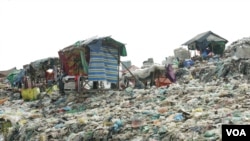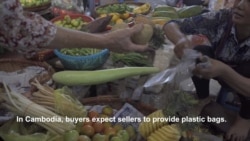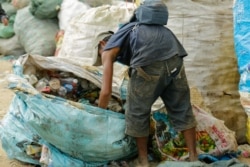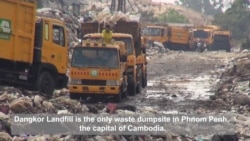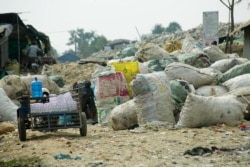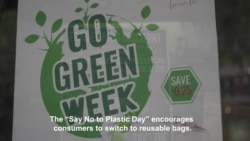Lang Teng and his wife Him Chan Ouen have sold vegetables for more than four decades. They own two stalls totaling four meters square in the Boeng Keng Kong market, where shoppers can get a haircut or purchase housewares on the way to buying groceries for the day’s meals.
Lang Teng opened his business in Phnom Penh not long after the murderous Khmer Rouge rule ended in 1979.
Today he remembers how shoppers arrived at the market back then, each with an empty basket. They moved from stall to stall, buying basics—vegetables, meat, fish, eggs—and tucking purchases into the baskets that always seemed to have room for another item.
Until the late 1990s, Lang Teng said vendors wrapped items in “leaves like banana leaves, [and] water hyacinth strings. Now, we don’t see that anymore.”
Today, people go to the market without baskets and return home with food wrapped in plastic carried in plastic bags. Even big blocks of ice are protected in plastic, a big change from the traditional way of tying up ice blocks with water hyacinth strings to carry them.
Cambodians of Lang Teng’s basket-carrying generation remember routinely living a life that produced little to no waste. With a per capita income of $103, they had little disposable income and weren’t big consumers. What they had, they used until it wore out, then repurposed whatever remained. Ahead of the trend, they lived a zero-waste life.
The Zero Waste International Alliance defines it as “the conservation of all resources by means of responsible production, consumption, reuse, and recovery of products, packaging, and materials without burning and with no discharges to land, water, or air that threaten the environment or human health.”
People in Cambodia’s capital city of Phnom Penh produce about 3,000 metric tons of solid waste every day. Nearly 60 percent of municipal solid waste comes from households, followed by hotels and guesthouses (16.7%), restaurants (13.8%), markets (7.5%), to shops (5.4%) and offices (1.4%), according to a 2016-2018 study by the United Nations Environment Program.
It is overwhelming, and after food waste (63.3%), plastic is the biggest category (15.5%), followed by grass and wood (6.8%), and paper and cardboard (6.4%), according to a September 2019 overview.
Local authorities opened the Dangkor Landfill in 2009, predicting it would swallow waste without a hiccup for the next 25 years. Designed at 31 hectares, after just five years, the first phase, comprising 14 hectares, was full, according to a 2016 case study, Reforming Solid Waste Management in Phnom Penh.
“Since opening, the amount of waste entering the landfill has increased from approximately 800 tons per day in 2009, to 1,475 tons per day in 2014, with some forecasts estimating that this will increase to 2,200 tons per day by 2020,” said the case study published by The Asia Foundation.
In May, 2019, Keo Channarith, director of the Dangkor Dumpsite Management Committee, told the Phnom Penh Post the dump would be full by the end of 2020 or early 2021.
“The expected lifetime of the Dangkor [Landfill] was much longer,” said Rajeev Kuman Singh, a police researcher at the Institute for Global Environmental Strategies (IGES) in Japan. He has consulted with the Cambodian government on waste management planning.
Rapid population growth, little organized recycling and growing prosperity were among the factors that lead to an exponential increase in the amount of waste that overwhelming the landfill, according to Singh. In 1979, Cambodia’s population was 6.77 million and in 2018, it was 16.2 million, according to the World Bank, which figured the per capita income was $1,510 in 2018.
In the Cambodian government’s Phnom Penh Waste Management Strategy and Action Plan 2018-2035, the focus is on waste management, which is the collection, transportation and disposal of waste. The 166-page document released in October 2018 discusses the importance of the “3Rs” (reduce, reuse, and recycle of waste) and the need to promote educate waste-producers on how to dispose of it properly.
Uncontrolled disposal is the “least favored option” and reducing waste, or minimization, is the “most favored option”.
“This zero-waste concept is applicable in Asian countries including Cambodia, however, achieving zero waste for Asian countries is a long journey” said Rajeev.
A seller across from Lang Teng’s stall made an observation. Fifty-year-old pork seller Chrin Chhenglea, said to reduce plastic it has to start from buyers.
“It’s possible when it starts from shoppers,” said Chhenglea. “Sellers like us don’t want to give out plastic bags; it has to start with shoppers. They should bring their own shopping bag.”
Chhenglea added it would be more effective if the campaign to reduce plastic use was promoted in markets like Beung Keng Kang because many Cambodian patronize them instead of the more expensive malls.
“I think if they talk more about it inside the wet market like this, we would be more informed,” Chhenglea said “everyone would be reminded to bring their own bags to shop.”
Activists and international NGOs say they are working to increase understanding of the 3Rs. Many are focused on reducing plastic waste.
At Sotheavy, founder of Think Plastic, a campaign that raises awareness about plastic usage and how to reduce it, thinks Cambodia may need to improve its basic waste management before embracing the notion of zero waste.
“I would never plan to be that extreme. I never thought about it, I could never see myself going toward zero waste at all,” At Sotheavy said. “It is too extreme.”
Although At Sotheavy supports the idea of zero waste, she asked, “How would we begin on step 10 when we’re only doing steps 1, 2 and 3? We just started to talk about waste management.”
And that conversation is going on as Lang Teng says his customers rely “on us giving away plastic bags.”
Baskets, banana leaves, and water hyacinth strings and trunks may have suited Cambodians when Lang Teng began his business, but four decades later, plastic is so cheap and so convenient that millions of plastic bags are used each day Phnom Penh, according to a 2019 report by the United Nations Development Program. The city with its metropolitan area has a population of about 2.2 million.
As long as the country lacks a waste management infrastructure, the report says “effective recycling of plastic waste in Cambodia is nearly impossible.”
While Cambodia needs to set up its system of waste management and reduce waste, the processes must be well thought out, according to Nick Beresford, UNDP’s country director in Cambodia.
“We want to be able to do this transition without the burden falling on the poorest people,” he said. “
“This is really at the heart of the issue that we are looking at with the government, because it’s no point to simply banning the use of plastic that we don’t have the particularly good alternatives,” said Beresford.




